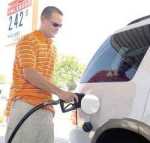More Southeast Missouri drivers look for ways to prevent gas tanks from guzzling their cash

SIKESTON -- Motorists may not be able to do anything about the rising price of gas, but there are some things they can do to get the best possible mileage with their vehicles.
"Don't burn the air conditioner first thing in the morning -- ride as long as you can without having to turn it on," suggested Earl Grissom of Sikeston as he filled up his vehicle Friday afternoon.
Starting a drive with the windows open exhausts the hot air out of the rear windows, and this also enables the air conditioning to work faster and more efficiently when turned on, according to Response Insurance.
With gas prices at record highs, Grissom said it takes about $50 of regular unleaded fuel to fill up his sport utility vehicle.
"I try not to get out in the peak time of the day, and I try to prioritize my schedule for the day and that helps," Grissom said.
In Sikeston the average price of self-serve regular gas ranges from a low of $2.39 to a high of $2.49, according to AAA. The average cost to fuel a vehicle with a 15-gallon tank is currently $32.61 -- up $1.38 from the average a month ago. It's also $7.18 higher than the average cost a year ago.
"Earlier this year we (AAA) did a survey of people and what they would be doing as prices reached up to $2.50 and even up to $4," said Mike Right, spokesperson for AAA in St. Louis said. "Many of them said they were already taking measures to reduce the costs."
And as the price of gasoline gets higher, a greater percentage of people will adopt fuel efficiency measures, Right said.
"The other thing people told us is they would be doing less or shorter leisure trips and looking at purchasing a much more fuel efficient vehicle," Right said, adding car pooling and moving closer to workplaces were solutions for some.
To help offset the cost of fuel, Right recommended utilizing the most fuel-
efficient fleet if a family has a choice of two vehicles.
"In other words, don't take the pickup truck to get a loaf of bread," Right said.
Motorists also want to get rid of any excess weight they're carrying in their vehicles.
"If you've got wood leftover on your truck or something adversely impacting your fuel economy, remove it," Right said. "So if you're going on a long trip, leave your mother-in-law at home," he joked.
Tires should be properly inflated; under inflated tires will rob a motorist anywhere from 2-4 percent, Right said. They also produce excessive heat and can cause tire failure or a blowout.
Shop for gasoline and take advantage of a few cents off, Right suggested. If someone is using an octane level higher than recommended, they may want to go down, unless the problem is very severe, he suggested.
"Other things a person can do is try to chain trips together to eliminate extra mileage," Right said.
Monitoring driving habits also helps, Right said.
"Anticipate stop signs, red lights and situations where you have to slow down. If you haven't had your car tuned up lately, it might be a good idea to do that," Right said, adding air and fuel filters should be replaced as recommended by the vehicle's manufacturer.
Eliminate any additional wind resistance on the vehicle, such as luggage containers on the top of vans, pickup trucks or SUVs.
"That will cost you anywhere from 5-10 percent," Right said.
Every 200 pounds of weight reduces gas efficiency one mile per gallon, Response Insurance reports.
Reducing speed also helps, according to Response. It's estimated that every mile per hour driven above 55 miles per hour costs 1 percent in fuel economy. Maintaining a constant speed also maximizes a car's traveling performance.
And that's a tip Joey Taylor said he practices. The New Madrid resident works in Sikeston and travels back and forth everyday.
"I drive the speed limit or below it and get better gas mileage," Taylor said.
Other than trying to get the most for their dollar, there's not much anyone can do about the rising prices.
"They're too high," Taylor said about the prices. "But you've got to go to work."

